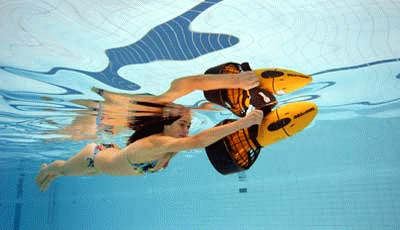Sea Scooter Basics
If you’re looking to introduce a little extra excitement and fun into your dives with a Diver Propulsion Vehicle ( DPV’s) as they are known to most, you get the difficult task of choosing just the right underwater scooter. DPV’s range from small sea scooters to small submarines, the hand held underwater sea scooter being the most popular.
You might be asking yourself what is the most important features I need to look for in a high quality sea scooter. Well, look no further as I have done the hard part for you. To know whether you are on the right path, keep reading my buying guide so you know what to look for as well as what to run away from!
The Fun Facts
 In the most simplistic form, these handheld sea scooters use an electrical motor to drive a propeller which generates thrust. The diver holds on with two handles, which also serves as the accelerator and steering mechanism. Speed is typically around a couple of knots, though some bigger DPV’s with more powerful motors can move a bit faster.
In the most simplistic form, these handheld sea scooters use an electrical motor to drive a propeller which generates thrust. The diver holds on with two handles, which also serves as the accelerator and steering mechanism. Speed is typically around a couple of knots, though some bigger DPV’s with more powerful motors can move a bit faster.
Tech divers love them, because they make long dives more comfortable and help to conserve gas during the dive, and make it easier to fight against any currents. Also, for very deep dives, they make dragging a number of stage bottles less awkward.
Non-tech divers also have a fascination with the small, compact units, though. They help to create the James Bond-effect while being dragged along behind a DPV, the whirring of the propeller in your ears.
But from a more practical perspective, they’re pretty useful as well. Dives that may feature a risk of strong currents is made much safer. Large reefs or wrecks are suddenly more manageable on a single dive, and the lack of the physical strain on the diver often means extended dive times as well.
Types
There are several types of DPV’s, from large sled-like types that can be used by two divers at a time, and carry quite a lot of cargo. To simple, compact types, where the diver holds onto the unit and is towed by it, called tow-behinds
Scooters, diver-tugs, tow-behind
The most common underwater sea scooter vehicles are those that tow the diver behind the scooter, the diver is holding on with both hands onto handles on the bow or stern. The tow-behind propulsion scooter vehicles are efficient since they place the diver above and parallel to the propeller wash. The diver has a harness that also has a D-ring at the front as well as a crotch strap. A releasable metal snap is rigged to the scooter with a tow leash that is clipped on the scooter. These underwater scooters are usually small and can be handled without any specialized equipment.
Manned Torpedoes
These are cylindrical or torpedo-shaped vehicles used by one or a number of divers sitting in a hollowed out inside frame where sitting in tandem. They can carry extra air tanks, have more rudimentary equipment such as gyro, magnetic compass, lights, and etc. The first torpedoes were used in World War II, and now similar ones are made for sport or work divers. These units are too heavy and bulky to be operated by individuals.
Manta-boards
These are boards that are unpowered and are usually towed by a surface boat using ropes. They have surfaces in the shape of airfoil that provide downward force when towed. The diver holds the board and uses an aerofoil to keep it submerged. By changing the ‘angle of attack’ (angle between ‘direction of speed’ and ‘direction of board’s longitudinal axis’), diver adjust diving depth . The boards got their name from the manta ray fish.
 Things to Consider During your Purchase
Things to Consider During your Purchase
- Buoyancy. Is usually a neutral to slight positive depending on the model. With a slight positive buoyancy ensures that if scooter is left unattended, it will slowly reach the surface. Neutral buoyancy is used mostly for professional underwater scooters, when left unattended but connected to the diver, it will float freely in the water and will not disturb the diver at work by pulling him up or down. Most of the higher end sea scooters will come with attachment points or removable cavities that allows the user to easily adjust the buoyancy with weights. The Sea Doo RS Series of sea scooters has an excellent design of being self-filling ballast hull to achieve neutral buoyancy almost instantly. Strategically placed drain holes allow water to freely enter and exit the ballast space making the Seascooter™ RS automatically assume neutral buoyancy when submerged, and expel water as soon as it hits the surface.
- Size of underwater scooters. They vary from small pool toys for kids such as the Sea Doo Dolphin and Sea Doo Aqua Ranger to professional underwater scooters. Small scooters weigh 12 pounds and can pull single diver at limited speed and usually have limited endurance (30 -90 minutes maximum, maybe a little bit more if not pushed too hard). Larger underwater scooters weigh up to 20-30 pounds and can easily be handled with one adult on the boat deck or shoreline area.
- Depth range. This can vary from a few feet for the smaller entry sea scooters to several meters for the higher end more professional scooters. At 40 meters this is a safe limit for safe scuba diving using ordinary air for breathing. Even then, one must use diving tables for decompression, unless dives were rather short (again, for safety reasons, check diving tables). If you are free diver, then use these devices according to your maximum diving depth and be very careful.
- Power output. Batteries can vary from a few hundred watts to few kilowatts. The stronger engine doesn’t mean more noise, since expensive models usually have better acoustic insulation, better bearings and better and larger propellers. Smaller underwater scooters often have high-pitch sound due to use of smaller, faster rotating electric motor and propeller. The energy source is almost exclusively batteries with the most common batteries being the NiCd, NiMH, LiPo and various lithium batteries. Again this depends on the size of the scooter, battery type, size, capacity, and the way the scooter is used. When scooter is pushed heavily and driven hard, it drains the battery fast, with running times often less than 10-15 minutes for cheap models. On the other hand, big scooters equipped with lithium batteries and large propellers, when used for slower diving around, can last for hours. Most of these devices have rechargeable batteries that are easily replaced. Always a good idea to have multiple batteries on charge to help extend your scooter usage.
- Scooter prices. This can vary from $100 or so dollars on up to several thousands (or even more) dollars in the most professional sea scooters. Those cheap ones are barely more than pool toys, while expensive ones are professional grade equipment that can withstand severe usage in a more hostile environment. If you have such expensive equipment (designed to be used by professional divers in extreme environments) and you use it carefully and maintain it as required, it performs flawlessly for long period of time.
